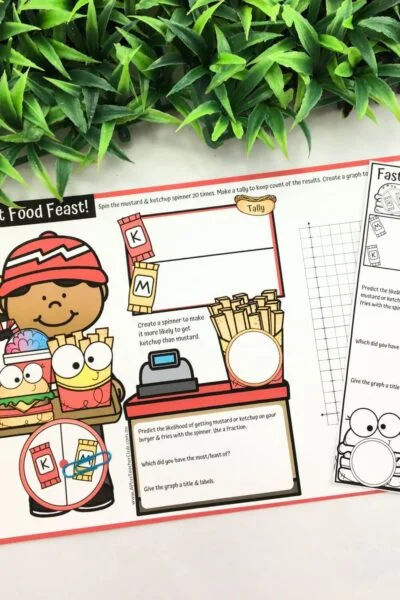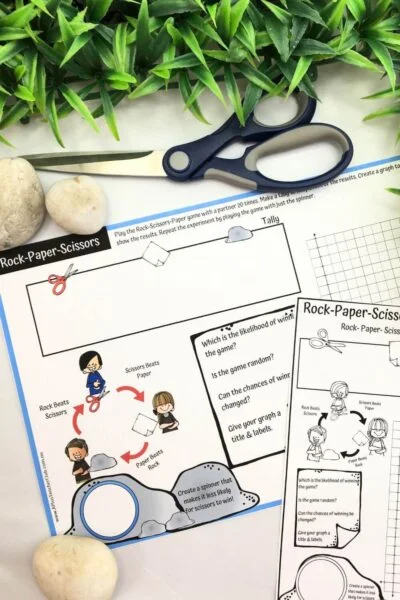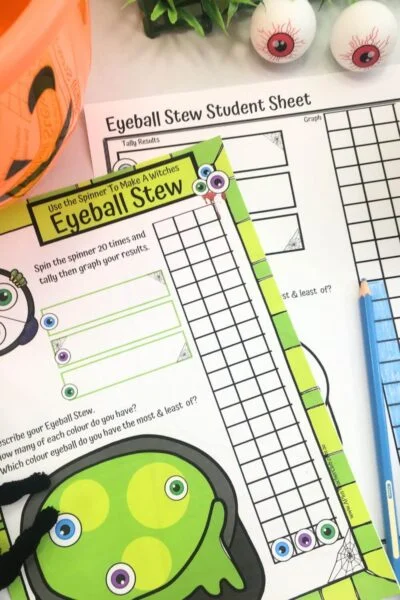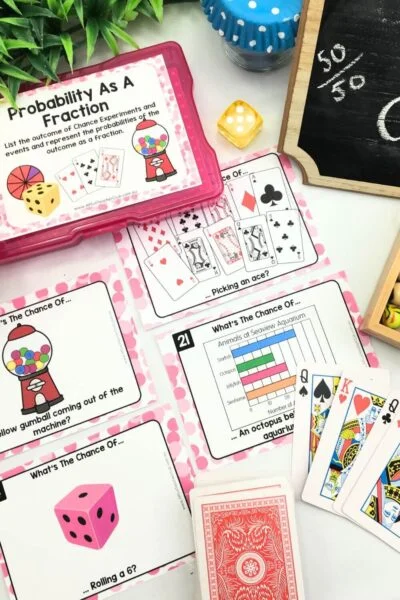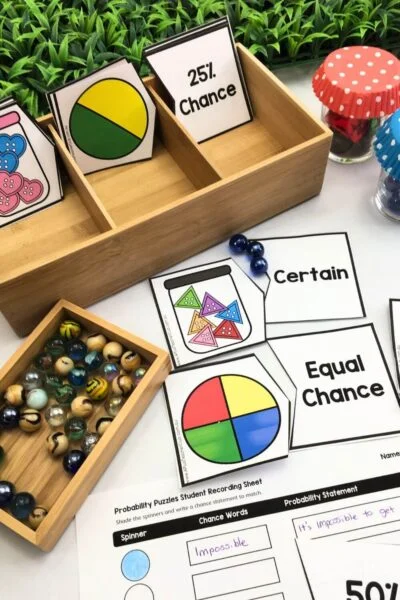Teaching Probability Activities
Statistics and Probability
Are you looking for ways to make probability fun and engaging for your students? Teaching probability can be challenging, but with the right teaching probability activities and resources, it can be an exciting learning experience.
In this blog post, we will explore what probability is, how to teach probability effectively, and common difficulties students may face when learning about probability. Plus, we’ll provide you with a list of 8 picture books about chance or probability that you can use in your classroom. Get ready to make learning about probability a blast!
Teaching Probability To Kids
Probability is the branch of mathematics that deals with the likelihood of events occurring. In the primary mathematics curriculum, students are introduced to probability through activities that involve identifying practical events and everyday activities that involve chance.
As students progress, they learn about the language of probability, such as likely, unlikely, certain, and impossible. They also learn to conduct chance experiments, describe possible outcomes, and order the chances of events occurring. When teaching about Probability, also known as Chance, you will need a range of probability activities to help students recognise that everyday events involve various degrees of chance.
Teaching Probability includes:
- Identifying outcomes of familiar events involving chance and describing them using everyday language such as ‘will happen’, ‘won’t happen’ or ‘might happen
- Identifying practical activities and everyday events that involve chance. Describing outcomes as ‘likely’ or ‘unlikely’ and identify some events as ‘certain’ or ‘impossible’
- Conducting chance experiments, identifying and describing possible outcomes and recognising variation in results
- Describing possible everyday events and ordering their chances of occurring
- Listing outcomes of chance experiments involving equally likely outcomes and representing probabilities of those outcomes using fractions
- Describing probabilities using fractions, decimals and percentages
Activities For Teaching Probability
Teaching probability can be a lot of fun for both you and your students. Here are some fun and engaging probability activities for kids that you can try in your classroom:
- Coin Toss: Flip a coin and have students predict if it will land on heads or tails. Record the results and have students analyze the data to determine the probability of landing on heads or tails.
- Dice Roll: Roll a dice and have students predict which number it will land on. Record the results and have students analyze the data to determine the probability of rolling each number.
- Spinner: Create a spinner with different colours or shapes and have students predict which one it will land on. Record the results and have students analyze the data to determine the probability of landing on each colour or shape.
- Card Game: Play a card game where students need to draw a specific card (e.g. ace of spades). Have students calculate the probability of drawing that card based on the number of cards in the deck.
- Jellybean Jar: Fill a jar with jellybeans and have students guess how many are in the jar. Record the results and have students analyze the data to determine the closest guess and the probability of guessing the correct number.
What Problems Do Students Have Learning About Probability?
Probability can be a challenging concept for some students to grasp. Here are some common problems students may have when learning about probability and how to overcome them:
- Misconceptions: Students may have misconceptions about probability, such as thinking that all events have an equal probability of occurring. To overcome this, use real-world examples and hands-on activities to show that this isn’t always the case.
- Difficulty with Fractions: Probability often involves working with fractions, which can be challenging for some students. Use visual aids, such as diagrams or pictures, to help students understand the concept of fractions.
- Lack of Vocabulary: Probability has its own set of vocabulary, such as “event,” “outcome,” and “probability.” Make sure to introduce these terms early on and use them consistently throughout your lessons.
- Misunderstanding the Concept of Probability: Students may have difficulty understanding what probability actually means. To overcome this, use concrete examples and explain how probability is used in everyday life.
Picture Books For Teaching Probability
Introduce the concept of probability to your students with a picture book! Here’s a list of 8 to help students understand Chance or Probability:
- “Probably Pistachio” by Stuart J. Murphy – This book is perfect for teaching probability to first, second, and third graders. Nothing goes right for Jack all day long. He can’t find his favourite sneakers, he spills milk on his math homework, and worst of all, he gets tuna fish for lunch. Will things ever get better? Readers will learn how to tell when something is certain, more likely, less likely, or impossible as Jack keeps hoping his streak of bad luck will break.
- “The Book of Probability” by Michael Berenstain – This book is a great resource for upper elementary students who are learning about probability. It includes clear explanations and examples of probability concepts and real-world applications of probability.
- “What Are the Chances?” by Joy N. Hulme – This book explores the concept of probability through a series of short stories that involve chance events. It’s a great way to make probability more relatable to students.
- “Probability for Kids” by The Clever Factory – This book includes a variety of fun and engaging activities that teach probability concepts such as probability language and chance experiments.
- “Bad Luck Brad” by Gail Herman – Brad is ready for summer vacation, but on his last day of school he discovers an important lesson. His chances of getting what he wants may not be based on luck. By estimating and calculating before making choices, he can increase the likelihood of those choices being the ones he wants. This title teaches the concepts of probability.
- “It’s Probably Penny” by Loreen Leedy – Lisa’s class is learning about probability. For part of her homework, she has to think of an event that will happen, one that might happen, and one that can’t happen. Who is that Boston terrier that keeps popping into Lisa’s imagination? It’s probably Penny!
- “A Very Improbable Story:” by Edward Einhorn – A Math Adventure by Edward Einhorn is a book that lends itself a bit more to older children. The storyline assumes that there is some current knowledge or understanding already in place about probability. The storyline is fun and creative and would appeal to a variety of age groups even though the concepts are more complex. A Very Improbable Story is great for sharing a variety of groups of items to practice finding the probability of a particular collection of objects.
- “Pigs at Odds: Fun With Math and Games” – by Amy Axelrod – A fun and adventurous book. The pigs head out for yet another math adventure, but this time at the carnival. Of course, a carnival is filled with opportunities to practice chance events and Axelrod touches on just about all of them. The great fun that the pigs have keep children engaged in this story while learning the concepts of probability.
Teaching probability can be a challenging but rewarding experience for both teachers and students. By incorporating hands-on activities and games, you can make probability more engaging and interactive for your students. Additionally, providing students with a variety of resources, such as picture books, can help make probability more relatable and easier to understand. Use these
Resources listed in this collection
Click to jump to...-
Probability & Data Investigations - Traffic Survey
-
Probability & Data Investigations - Fast Food
-
Probability & Data Investigations - Rock Paper Scissors
-
Probability & Data Investigations - Witches Brew
-
Probability & Chance Task Cards Set 1 - Everyday Events Likelihood Vocabulary
-
Probability & Chance Task Cards Set 2 - Events As Fractions
-
Probability & Chance Puzzles - Vocabulary
Probability Activities
Explore tags
More Probability Activities

Statistics & Probability - Chance & Data
Can't find what you're looking for?
Send us a request! Use this form to request a resource. Please give details of the learning area, topic, year level, curriculum links. We’ll be happy to take a look to see if we can fit it in. Unfortunately a request does not guarantee we will be able to make it!
"*" indicates required fields


